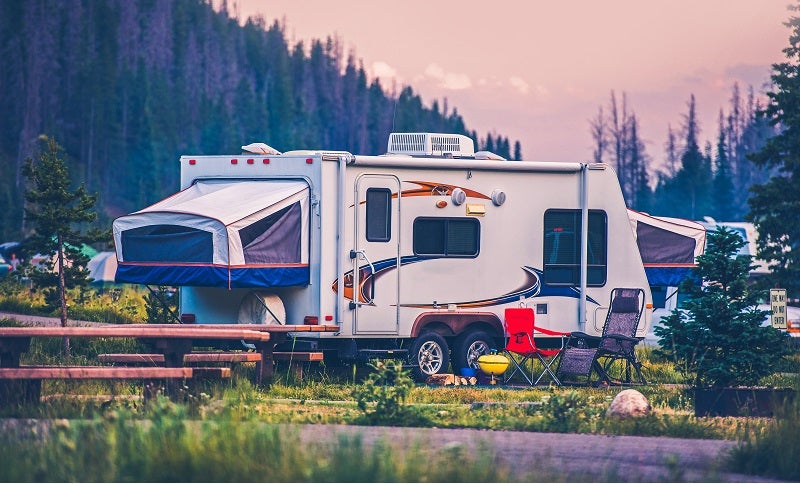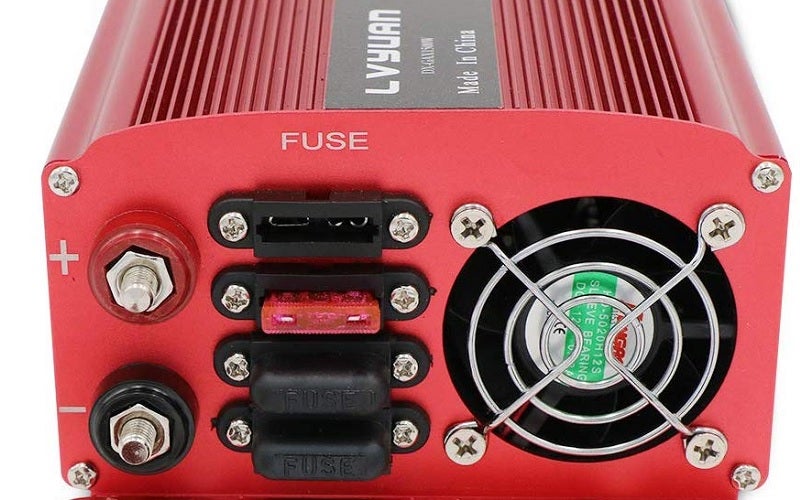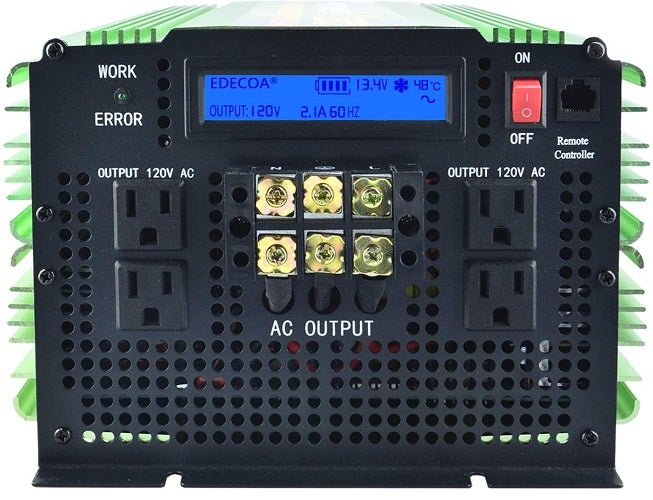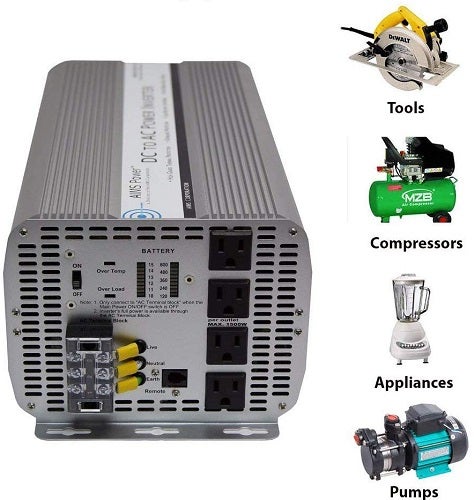
Our Editors independently research, test, and rate what we feel are the best products. We use affiliate links and may receive a small commission on purchases.
RV power inverters are a convenient way of powering appliances and accessories where there is no reliable means of electricity available. They are also incredibly useful during emergency situations or on camping trips.
This guide will show you our top RV power inverters and some of their features. We’ll also explain things you should look for in a reliable inverter.
In the end, we’ll answer some frequently asked questions and, hopefully, give you a better understanding of these power inverters.
Best RV Power Inverters
For more of my RV recommendations, have a look through these popular Outside Pursuits guide links: RV Solar Panels & Kits, RV Deep Cycle Batteries, RV Generators.
Quick Answer: The 5 Best Rated RV Power Inverters For 2021
- Giandel 5000W Heavy Duty Power Inverter w/ Remote
- GoWISE Power PS1004 3000W Pure Sine Wave Inverter
- AIMS 5000 Watt Power Inverter
- Yinleader 1500W/3000W Power Inverter
- EDECOA Pure Sine Wave Power Inverter
Our reviews of the top rated RV inverters with our buyers guide and comparison table will help you choose the right one for you.
RV Power Inverter Reviews
#1 Giandel 5000W Heavy Duty Power Inverter w/ Remote
- Output: 30 amps; 5,000 watt rated, 10,000 watt peak
- AC Outlets: 4
- Remote Control: Yes, with 15-foot cable
- Weight: 22 pounds
- LCD Display: No
Giandel is a leader in power inverters, and they definitely show it off with their 5,000-watt Heavy-Duty Power Inverter.
This is by far the best RV inverter available on the market. It is a must-have for road trips, emergency kits, and other applications.
This heavy-duty modified sine wave inverter can supply 5,000 watts of power continuously with a peak of 10,000 watts. This means that it can easily power most household electronics and appliances.
Giandel’s inverter is built for durability and reliability. It is housed in a solid, sturdy aluminum alloy casing. You won’t have to worry about rust or corrosion with this inverter and can rely on it to perform to your needs and expectations.
While it does have four AC outlets, this unit has an AC terminal block that allows you to deliver the entire, continuous 5,000 watts of power to just one source. This is fantastic if you need to power a larger, heavy-duty appliance or piece of equipment.
With a low-voltage alarm, the unit will produce an audible sound in the event of a short circuit, as well as in instances of thermal or overload issues.
It is designed to protect itself if you can’t. This inverter has an automatic shutdown short circuit system that will fully protect it from and possible circuit-related damages.
The remote control for this inverter comes with a 15-foot cable, so you don’t have to be very close at all to operate it. With an additional 2.4A USB port and the four AC outlets, you can rest assured that you can power as many or as few devices as you want or need with no hassle.
Giandel offers fantastic customer service and an 18-month warranty. With all the features and these additional perks, plus the pure power of this inverter, it’s no wonder it’s our top pick for best RV inverter.
#2 GoWISE Power PS1004 3000W Pure Sine Wave Inverter
- Output: 25 amps; 3,000 watt continuous with 6,000 watt surge
- AC Outlets: 4
- Remote Control: Yes, it has a remote switch
- Weight: 9.9 pounds
- LCD Display: No, but has an LED indicator light
The best pure sine wave inverter currently on the market according to many users is the GoWISE Power PS1004 Inverter. It’s a fantastic solution during emergencies if your power happens to go out.
Running on a pure sine wave, this inverter generates a smooth, clean output. These types of inverters tend not to suffer from fluctuations or surges, which protects you and your appliances or devices.
It’s extremely versatile in use. It is compatible with not only RVs, but also with boats, cars, personal computers, and generalized camping gear that requires a power source.
Additionally, converting DC power to AC is extremely simple with this inverter. With a total harmonic distortion of less than 3%, it is at the perfect threshold for pure sine wave.
This inverter features an impressive five systems of protection. These include thermal protection, overload protection, over- and under-voltage protection, and a low-voltage protection alarm.
All of these systems are designed to protect your inverter as well as anything plugged into it. There is an LED indicator light that will let you know if there’s a problem. Two cooling fans are included in the inverter and keep it from overheating while operating.
Weighing in at under 10-pounds, this inverter is compact and portable. It easily fits into limited spaces. It has a convenient USB port and comes with a wired remote as well as starter cables. You won’t go wrong by using this inverter for almost any needs you have!
#3 AIMS 5000 Watt Power Inverter
- Output: 41 amps; 5,000 watts
- AC Outlets: 4
- Remote Control: No, however, you can order a remote from the manufacturer
- Weight: 18 pounds
- LCD Display: No
The AIMS 5000-Watt Power Inverter is one of the best power inverters for your RV.
The AIMS model of inverter actually comes in different models that can put out a range of wattages, with the lowest being 2,000 watts and the highest being 10,000 watts.
The AIMS 5,000 model gives off an impressive amount of power that is guaranteed to meet the vast majority of your electrical needs in emergencies or on the road.
Keep in mind that this isn’t a pure sine wave inverter. It uses a modified sine wave, instead.
This unit has impressive phase correction technology. This allows the inverter to keep its power efficiency without drawing any extra load current.
This is a great feature to have, especially in such a high-powered inverter. There are only a few inverters that reach 5,000 watts as a continuous standard, and AIMS is at the top of that list. They’ve made a durable, quality inverter that will easily and consistently meet your needs.
As far as modified sine inverters go, this is the best of the best. That is primarily because this inverter draws ranges between 90 and 95 percent efficiency.
The other main reason is that this particular power inverter has a no-load current draw of 0.6A, which is better than even some pure sine wave power inverters.
This inverter comes with pre-wired for a remote on/off switch. It also has features like AS output short circuit protection, overload and over-temperature LED indicators and a thermally-controlled cooling fan.
Overall, you can’t beat the power that this inverter offers. Especially not at its comparatively low price – it’s meant to fit well within any budget while offering optimum power output.
This inverter would be a great investment for anyone looking to add an RV power inverter to their lives.
#4 Yinleader 1500W/3000W Power Inverter
- Output: 40 amps; 1,500 watts continuous, 3,000 watt peak
- AC Outlets: 2
- Remote Control: No
- Weight: 75 pounds
- LCD Display: No, but it does feature an LED display
If you happen to be on the hunt for the best inverter for camping, look no further than the Yinleader 1500W/3000W Power Inverter.
Yinleader is a professional inverter supplier at the head of the pack in the industry. Yinleader is committed to providing quality products at the best prices.
This inverter is unbelievably small and weighs only 3.75 pounds. It is by far the lightest inverter on our list, but it’s no less impressive. This compact RV power inverter is a must-have for road trips, camping, and other outdoor activities.
This inverter has a continuous AC output power of 1,500 watts. It peaks at 3,000 watts, and while that may not seem like much in comparison to the other inverters on this list, don’t let it fool you. Some customers have used this inverter with electric pole saws and televisions.
While impressive, this inverter shouldn’t be put to task with appliances such as air conditioners or refrigerators. It also should not be used with high-powered electronic devices like curling irons or electric space heaters.
It has multiple protective features packed into its small, yet durable, aluminum alloy body. It has protective measures against overloading, short circuits, overheating, reverse polarity, and under- or over-voltage. Your batteries and appliances will be totally safe, and so will your inverter.
The cables included with this model of inverter are a 12V cigarette lighter cable and a battery clip cable. It has two AC outlets, as well as two 3.1A USB ports.
This makes it perfect for charging phones, GPS units, and more. Plus, you could use it for a low-powered burner or similar equipment while you enjoy the outdoors.
With a solid five-star rating on Amazon, it’s hard to argue that this isn’t a fantastic little inverter, so long as you don’t try to make it work beyond its capacity.
You should give it a chance if you have some small devices or appliances you want to power on your next outing!
#5 EDECOA Pure Sine Wave Power Inverter
- Output: 3,500 watts continuously, 7,000 watts peak
- AC Outlets: 4
- Remote Control: Yes, with a two-meter-long standard network cable
- Weight: 16 pounds
- LCD Display: Yes
One of the best sine wave inverters out there is the EDECOA Pure Sine Wave Power Inverter. With an array of attractive and useful features, this unit had to make our list.
This sine wave inverter is the perfect solution for your camping, boating, recreational, or emergency power needs.
You can even use this inverter to set up a fully-off-the-grid solar power system, and together they would easily be able to power all of your electrical appliances.
Similar to other products in its class, this inverter comes with built-in fan controls, automatic voltage regulation, and an intelligent power management system.
With four outlets and a hardwired terminal, you won’t have any trouble powering your appliances or equipment.
This unit has a fully-functional LCD display. This display can show you the battery voltage, charge, and pattern. It will also display the inverter’s output voltage, and the display will flash when the inverter is in protection mode.
This is a fantastic inverter for almost any use, especially for any outdoor activities where you won’t have easy or reliable access to electricity otherwise.
RV Power Inverter Comparison Table
| RV Power Inverters | Power Output | AC Outlets | Remote | Weight | Rating | |
|---|---|---|---|---|---|---|
| Giandel Heavy Duty Power Inverter | 30 amps; 5,000 watts | 4 | Yes | 22 lbs | 4.5 / 5.0 | |
| GoWISE Power Pure Sine Wave Inverter | 25 amps; 3,000 watts | 4 | Yes | 9.9 lbs | 3.9 / 5.0 | |
| AIMS 5000 Watt Power Inverter | 41 amps; 5,000 watts | 4 | No | 18 lbs | 4.0 / 5.0 | |
| Yinleader Power Inverter | 40 amps; 1,500 watts | 2 | No | 3.75 lbs | 5.0 / 5.0 | |
| EDECOA Pure Sine Wave Inverter | 3,500 watts | 4 | Yes | 16 lbs | 4.1 / 5.0 |
How to Choose the Best RV & Camping Inverter – Buyers Guide

Your RV inverter is made to convert 12 VDC power into 120 VAC power, which is the standard that most appliances, devices, and other electronics use regularly. But, there are two types of inverters you should be aware of before shopping around.
Inverter Types
Pure Sine Wave Inverters
Typically more expensive, but also more refined, pure sine wave inverters are necessary for safely providing power to some appliances, electronics, and devices. The power produced by these inverters is equal to, or sometimes better, than the power in your own home.
These inverters work the best for televisions, laptops, and other, similarly-sensitive electronic equipment. Pure sine inverters offer a safe, clean energy that can power nearly any AC-compatible appliance or device without any risk of damage.
Modified Sine Wave Inverters
Modified sine wave inverters are arguably the more affordable, all-purpose inverters. They utilize a more basic kind of technology than the pure sine alternatives, but it still perfectly good for powering electronics.
Modified inverters are typically best for less sensitive appliances. This includes phone chargers, heaters, and air conditioners. They suit resistive loads that don’t have a start-up surge the best.
Now that you know the basics of the different kinds of inverters, it’s time to get into more specifics. There are a lot more factors than just type that you should consider before making your purchase.
Deciding the Inverter’s Use
You shouldn’t ever buy something that you don’t have a solid, intended use for. This is a rule that holds true for inverters as well.
What do you plan on using the inverter for? Will it be used to supplement a solar panel system or charge devices on the road? Will you use it for emergencies or leisure?
Keep in mind the type of environment you intend to use the inverter in and have an idea of how many potential appliances or devices you’ll end up plugging into the inverter. You don’t want to buy an inverter with fewer outlets than you’ll need, but over-buying may also be a waste.
Checking the Wattage
The wattage of your power inverter is one of the most important factors to consider. This is because the wattage number determines exactly what devices you can safely plug into the inverter to be powered, and how many devices can be powered at a time.
The output power of your inverter must exceed the requirements of the device or appliance you intend to attach to it. If you intend to plug in multiple devices, the output of each outlet on the inverter should match the requirements of the connected device.
Before buying or deciding on a specific inverter, check the devices you plan to attach to it. Check the manufacturer’s recommendations as well as your owner’s manual. This will avoid the purchase and use of an under or overpowered inverter.

Available Continuous & Surge Power
From minutes to hours, the continuous power of your inverter is how long and at what wattage it can maintain providing power. This will be the main power type you look for when checking the wattage of not only the inverter but also the devices you want to plug into it.
Surge power, in contrast, is the starting wattage power of a device. Most devices and appliances require a higher surge power rating but a lower continuous power rating. If your inverter fails to charge or power a device, it’s likely because its surge power rating is too low for the device you’ve plugged into it.
What is the Output Voltage?
Output voltages are determined by the standard of the country an inverter is sold or manufactured in. Pure sine wave inverters, for example, are designed primarily for use in the United States. As such, they are designed to operate according to the standard voltage of the country.
Most inverters are designed to put 100 to 120V of power out without interruption. The connection should be smooth and free of circuit failure from power levels that are too high or low. The voltage level helps to operate any and every device, so make sure to buy the most suitable and proper inverter for your needs.

Protective Measures
While most modern inverters come with an array of protective measures, one of the most important is an overload protection method. An inverter without proper overload protection will lead to damages in your batteries, connected devices, and itself.
Make sure that any inverter that you are considering for purchase has at least a method of overload protection. Other great protective measures to look for are:
- Fan controls
- Voltage protection and regulation
- Overheating protection
- Over- or under-voltage protection
- Power management
LED or LCD Displays
LED and LCD displays can be a huge game-changer in your experience using your power inverter. LED displays or indicator lights can alert you to a problem as soon as the sensors detect that there is one.
LCD displays may be particularly advanced and able to inform you of exactly what problems your inverter is encountering. These displays are typically more helpful than LED displays on even the most basic level.
While it may seem like a small convenience, you’ll be thankful for an LED or LCD display if something ever happens to cause an error or problem in your inverter. It’s worth it to seek out a unit with this feature.
Warranties, Guarantees & Return Policies
As with any purchase that will cost a good chunk of your budget, you should give consideration to any return policies, guarantees, or warranties on the product you’re interested in. Check the manufacturer’s website, talk to their customer service team, and read as much as you can on their policies.
Some manufacturers will offer a full warranty or guarantee for anywhere from thirty days to five years. Some will have hassle-free, no-questions-asked returns for up to thirty days. Every manufacturer will operate differently.
This is not only to protect you in your purchase, especially online. This is to give you security in your purchase and make sure that the manufacturer is ready and willing to stand behind their product. Promises like this can speak volumes on the quality of the product in question.
FAQs About Power Inverters
Q: Can you use a power inverter with a solar panel system?
A: You can absolutely use a power inverter with a solar panel system. In fact, a lot of people use them. They can be used on trips or during travel, as well as at home in an off-the-grid or eco-friendly environment.
Solar panels attached to inverters typically deal with less voltage power and more current. They still switch from DC power to AC power, which is what most appliances use to function, so there’s no need to worry about rewiring your entire home to accommodate the addition.
Solar panels, through the use of solar cells, convert the sun’s energy into DC power. This, if connected directly to your RV, will charge the RV’s batteries.
However, when paired with an RV power inverter, the DC power collected by the solar cells is converted immediately to AC power. This makes it usable for all of your appliances, devices, and even lights.
You will typically have to buy an entire solar panel and RV inverter kit, however. Unless you’re particularly handy or well-versed in what’s needed to combine these two power course, a kit and professional installation are usually the best option. This will guarantee that every component is properly installed and ready for use.
Q: What’s the difference between a converter and an inverter?
A: If you’ve been looking for a great inverter and keep seeing mentions of converters, don’t fret – you aren’t looking for the wrong thing. Converters and inverters are both useful and have their place.
Converters are standard equipment on most modern RVs. These change 120V AC power to 12V DC power, and supplies power to the RV to charge its batteries.
Inverters do the opposite. Inverters turn the DC power to AC power. These are becoming more popular as included equipment in modern RVs, but they are not standard, and you may still have to purchase one separately.
Q: Do you need an RV power inverter?
A: The question of whether or not you need an RV power inverter, and thus the answer, will depend entirely on your wants and needs for what you want to accomplish. If you don’t mind the noise and vibration of a generator, you may not need an inverter.
However, people who occasionally or typically end up visiting places that don’t provide electrical hookups will find great use in an inverter. They also work fantastically with solar panels, both on the road or for an off-the-grid living situation.
Power inverters also allow you to operate appliances and devices like microwaves, DVD players, televisions, computers, and more. Depending on the inverter type and output voltage, you can run many large or small appliances as needed.
Q: What can you use your power inverter for?
A: You can use your RV power inverter for almost any small electronic device, appliance, or your entire home if you want. You just have to be sure that the inverter can handle whatever power load you intend to have it deal with.
You can use your inverter to power:
- Microwaves
- Televisions
- DVD players
- Computers
- Air Conditioners
- Space Heaters
- Phones (with their appropriate charger)
- Laptops
- And more!
How We Researched
To come up with the top RV power inverters, we researched a variety of sources for reviews such as Camping World, Lazy Days, Real Truck and Walmart along with our own personal experience.
We also consulted online magazines for product research and reviews to get as much unbiased information as we could. To help weed out fake reviews we used Fakespot.com to make sure we only looked at genuine reviews.
With so much quality gear available, we had to narrow it down based on what we felt were the best options for the price. The staff authors have a wide and varied background in RV camping, automotive repairs and backpacking.
The authors have decades of experience and are eager to share their knowledge with readers.
To help narrow down the selection we used personal experiences along with recommendations from mechanics and retailers.
After extensive research, we came up with our list to help you choose the right one for you.
Sources

